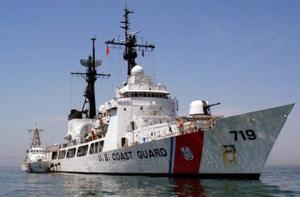Coast GuardPoor oversight, cost overruns plague Coast Guard’s modernization efforts
More than $7 billion and ten years later, the U.S. Coast Guard has only built two ships out of its original twenty-five year, $24.2 billion plan to replace its aging fleet with more than 250 new or upgraded vessels; given the service’s procurement track record, Congress is hesitant to continue funding a program plagued by cost overruns, delays, and management problems

Fletcher class cutter USCGC Boutwell // Source: weebly.com
More than $7 billion and ten years later, the U.S. Coast Guard has only built two ships out of its original twenty-five year, $24.2 billion plan to replace its aging fleet with more than 250 new or upgraded vessels.
Some of the Coast Guard’s ships date as far back as World War II, but given the service’s procurement track record, Congress is hesitant to continue funding a program plagued by cost overruns, delays, and management problems.
“Congress wants to work with the Coast Guard to meet their needs for its myriad missions, but will not simply supply a blank check,” said Representative Frank LoBiondo (R - New Jersey), the chairman of the House Transportation and Infrastructure subcommittee which oversees the Coast Guard.
Following the 9/11 attacks, Congress began distributing billions of dollars to bolster security capabilities including the Coast Guard, but budget cuts in the 1990s forced the service to shrink its procurement and contract management office leaving it ill prepared to handle the sudden surge in funds.
“I’ll be the first to admit, we weren’t prepared to start spending this money and supervising a project this big,” said Admiral Robert Papp, the commandant of the Coast Guard.
To assist in the management of Deepwater, the project name for the Coast Guard’s modernization efforts, the service relied heavily on Integrated Coast Guard Systems LLC, a joint venture between Northrop Grumman and Lockheed Martin, which proved problematic.
“In essence the contractors were overseeing themselves,” said Representative Bennie Thompson (D-Mississippi), the ranking member on the House Homeland Security Committee.
So far the Coast Guard has only completed two ships with two more under construction. At this point, the service was originally scheduled to have at least eight new ships already deployed or about to be delivered.
Of the $7 billion spent, the two completed ships and the two under construction cost about $2 billion and the remaining funds were spent on new contracts for at least ten more ships and improvements on more than two dozen older ships.
In a particularly ill-fated contract, the Coast Guard tasked Bollinger Shipyards Inc. with converting its 110-foot patrol boats into 123-foot vessels by attaching a new steel hull to extend the ships. The job was so badly botched, the Coast Guard was forced to decommission the eight ships the contractor had worked on.
“What we found out was when you put new steel on old steel, it flexes,” Admiral Papp explained. “Those patrol boats were unusable afterward and there was a chance of a catastrophic failure.”
The Coast Guard has made several changes in an effort to better manage its contracts including mandatory appropriations law training for its acquisition staff and secondary review of all large acquisition contracts.
Commander Matthew Lake, with the Guard’s Office of Budget and Programs, maintains that the service has “learned from those earlier challenges and we’ve made significant improvements.”
A recent Government Accountability Office report concurred with Commander Lake’s assessment concluding that the Coast Guard had done a better job with oversight, but the “$24.2 billion program as envisioned in 2007 is no longer feasible, in terms of cost and schedule.”
Admiral Papp is pushing for the continued funding of the program citing the fact that the service spends large amounts of money and time making repairs to old ships and could actually save money in the long-run with a newer fleet.
“It’s cost us way more to keep (older ships) operational than it should,” he said. “We are far surpassing the amount that we get in our budget to do routine maintenance on these ships, so that comes at the expense of doing maintenance to our newer ships.”
Before the program can move forward though, Representative Thompson said the Coast Guard must address the weaknesses that auditors identified within the program if it is to receive additional funds.
“I think to come to Congress with an incomplete program will only push the improvements required that much father back,” he said. “Clearly the Coast Guard needs to have its fleet modernized, but we have to have … to know exactly the work to be performed and how much it is scheduled to cost.
